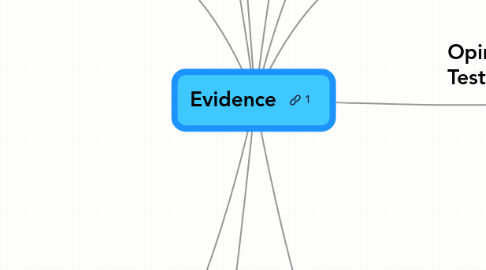
1. Relevancy Limits
1.1. Balancing Test
1.2. Prior or subsequent actions
1.3. Character Evidences
1.3.1. Civil Cases
1.3.1.1. Actions where Character is at Issue
1.3.1.2. Examples
1.3.2. Criminal Cases
1.3.2.1. D's Good Character
1.3.2.2. MIAMI KOPPS
1.3.2.3. Victim's Bad Character
1.3.2.4. Examples
1.3.2.4.1. Accused offers Character E of V
1.3.3. Habit
1.4. Legal Relevancy against Public Policy
1.4.1. Sequential Remedial Measures
1.4.2. Offers to Compromise
1.4.2.1. Severance
1.4.2.2. Medical Bills
1.4.2.3. Plenty of Insurance
1.4.2.4. Pleas and Plea Discussions
1.5. Sexual Conduct
1.5.1. Rape Shield Law
1.5.2. Exceptions
1.5.3. Child Molestation
2. Privileges
2.1. Essay Topics
2.1.1. Protected Relationship
2.1.2. communication
2.1.3. confidentiality
2.1.4. holder of priv
2.1.5. waivor
2.1.6. exception
2.2. Applicable Law
2.3. Atty / Client
2.3.1. Generally
2.3.2. Third Parties
2.3.3. Waiver
2.3.4. Exceptions
2.4. Phsycotherapist / Patient
2.4.1. Generally
2.4.2. Exceptions
2.5. Husband and Wife
2.5.1. Spousal Privilege
2.5.2. Marital Communications Privilege
2.6. Clergy Man Privilege
2.7. Other Privileges
3. Witnesses
3.1. Generally
3.2. Judges
3.3. Juror
3.4. Impeachment
3.4.1. Collateral Matter Rule
3.4.2. 4 Methods
3.4.2.1. Bias
3.4.2.2. Sensory defects
3.4.2.3. Character
3.4.2.3.1. Reputation or Opinion
3.4.2.3.2. Bad Act
3.4.2.3.3. Felony Conviction
3.4.2.3.4. Crimes of dishonesty or False Statements
3.4.2.3.5. Examples
3.4.2.4. Prior Inconsistent Statements
3.4.2.4.1. PIS Generally
3.4.2.4.2. Offered into Evidence
3.5. Examining W
3.5.1. Leading Question
3.5.2. Writing Used to Refresh Memory
3.5.2.1. Adverse Party may then
3.5.3. Exclusion of Witnesses
4. Authentication
4.1. Types of Evidence
4.1.1. Testimonial
4.1.2. Tangible
4.1.2.1. Read Evidence
4.1.2.1.1. Documents
4.1.2.1.2. Sound Recording
4.1.2.1.3. Handwriting
4.1.2.1.4. Voice ID
4.1.2.1.5. Telephone Calls
4.1.2.2. Demonstrative evidence
4.2. CONTAC - Self-Authentication
4.3. Issues Proponent Must Overcome RE Admissibiity
5. Contents of Writings, Recordings and Photos
5.1. Original Document Rule (Best Evidence)
5.1.1. Applies
5.1.2. Independent Source Rule
5.1.3. Substitutes for Original
5.2. (LOCS) Rule of Exceptions
5.3. Public Records
5.4. Summaries (Substantively)
5.5. Testimony or Written Admission of Party
6. General Provisions
6.1. Approach for MBE Issues
6.2. Govern
6.3. Does Not Govern
6.4. Objections
6.5. Preliminary Facts
6.5.1. Mandatory
6.5.2. CAP Rule
6.5.3. Standard of Proof
6.6. Mandatory
6.6.1. CAP Rule
6.6.2. Conditional Relevancy
6.6.3. Limited Admissibility
6.6.4. Require W to take Oath
6.6.5. The Rule
6.6.6. Judicial Notice
6.7. Related Statements
7. Judicial Notice
7.1. Not subject to reasonable dispute
7.2. Readily ascertainable and cannot be disputed
7.3. Mandatory If
8. Presumptions
8.1. Burden Shifts
8.1.1. Affirmative defenses
8.1.2. Presumption
8.2. Burden Levels
8.2.1. Prepond of the Evid
8.2.2. Clear and Convincing
8.2.3. Beyond a Reason Doubt
9. Opinions and Expert Testimony
9.1. Opinion Testimony by Lay
9.1.1. Requires
9.1.2. Scope - VEMPSS
9.2. Testimony by Experts
9.2.1. Requires - SKEET
9.2.2. Daubert - Gatekeeper
9.2.3. Basis of Opinion
9.2.4. Balancing Test
9.2.5. Ultimate Issues
10. Hearsay
10.1. Definition
10.2. Analysis
10.3. Non-Hearsay Purposes
10.3.1. Statement of mind
10.3.2. Verbal Acts
10.3.3. CAPPP Rule
10.3.3.1. Co-conspirators
10.3.3.2. Admissions
10.3.3.2.1. Direct Admission
10.3.3.2.2. Adoptive Admission
10.3.3.2.3. Authorized Admission
10.3.3.2.4. Vicarious Admission
10.3.3.3. Prior Sworn Inconsistent Statments
10.3.3.4. Prior Consistent Statements
10.3.3.5. Prior Identifications
10.4. Exceptions - Availability Immaterial
10.4.1. Present Sense Impression
10.4.2. Excited Utterance
10.4.3. Then Existing Mental, Emotional, or Physical Condition
10.4.4. Statements for Purp of Medical Diagnosis
10.4.5. Recorded Recollection (Past Recollection)
10.4.6. Records of Regularly Conducted Activity (Business Records Exception
10.4.7. Absence of Entry in Records
10.4.8. Public Records and Reports
10.4.9. Other Exceptions
10.5. Exceptions - Declarant Required to be Unavailable
10.5.1. Unavailability Definition
10.5.2. Former Testimony Rule
10.5.3. Statements Under Belief of Impending Death
10.5.4. Statements Against Interest
10.5.5. Statements of Personal or Family History
10.5.6. Forfeitur by Wrongdoing
